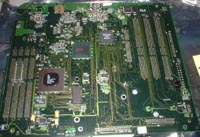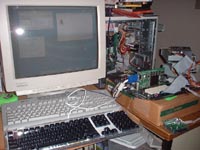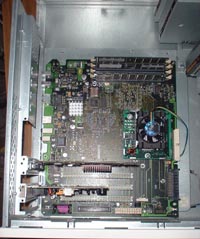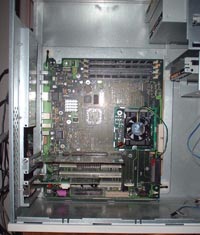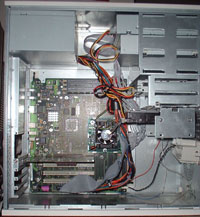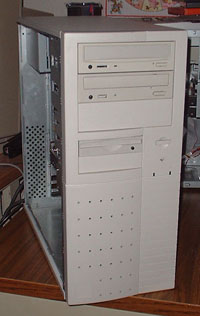


![]()
Logic Board, CPU, and PC Case
Word of caution: the back of the logic board contains several chips. One of these chips needs cooling and thus it's recommended that a tiny heat sink be mounted on the large "Philips" chip (lower left in the photo). It's clearly marked, and if you happen to pull the logic board out of your own G4 case, you'll see the small aluminum block on the door of the chassis. You must use caution when installing the logic board not to damage any of these chips. In order to cool this properly, you might look at a local computer store and see if they have any bad motherboards around. The small heat sink found on the a typical 440BX chipset's northbridge is sufficient.
Before you fully assemble the items in the case, it's generally a good idea to test out all the parts prior to mounting. This can save some headache later if something fails to work as it gives you an idea as to whether the parts originally worked or not. I don't recommend this unless you have some experience in doing this since a careless screwdriver or spilled drink can ruin several hundreds of dollars of equipment quickly.
Given the location of the ports and the AGP and PCI slots, the G4 logic board will line up nicely in most ATX cases. I happened to have a customized case on hand, so I decided to mount the logic board at the bottom of the case. In most instances, the ports on the back of the G4 logic board will simply fit in the ATX back panel area once the back panel is removed (the back panel is the metal plate surrounding the various I/O ports). As you can see, the AGP card and a simple PCI card can be used to help guide the logic board into the place you want it.
The only major issue here is that none of the holes in the G4 logic board are likely to line up with any of the ATX standoffs. Thus, you have two options:
-
Line up the board where you want it, mark several of the holes in strategic places where stress is most likely (such as near the PCI slots or memory slots since force downward is usually required to install those items). Then remove the board, and use a drill, die, and tap to make new threaded holes for the brass standoffs that came with the case. This is a more permanent solution if you have the tools.
-
Use nylon adhesive backed anchors in the corners and use wire ties to secure the board. The AGP and PCI cards will be screwed to the case and will keep the board from moving. Not the best solution, but it works.
Once you've secured the board, hook up the hard drive cables and the power. The power cord and IDE cables are keyed to only fit one direction. Make sure your drives were setup to distinguish between master and slave (if applicable). Then, hook up your front panel connectors using the guide on the logic board page. PC cases also have a hard drive LED and this LED won't be used in this project.
At this point, this is what it might look like when the assembly is done. I have a 30GB drive, a ZIP drive, a CD-ROM drive, and, a DVD-ROM drive in my case. This is impossible to do in any of Apple's cases due to the design of the Apple heat sink (which is designed to fit around the CD-ROM/ZIP drive bay).
Now that you're done, turn it on and begin installing your operating system (if applicable). I recommend downloading one of the G4 cache control utilities and run a looping demo overnight (such as a game benchmark) so that you can be assured that everything is in proper working order. The G4 cache control utilities will let you monitor the CPU temperature and the looping demo helps to "heat up" the components to check for instability.
-
Main project page.
-
Places to obtain parts.
-
Brief look at the various models of G4 Power Macs.
-
Processor module and heat sink fabrication.
-
Quick look at the logic board.
-
Installing the parts in the case.
Prior page: Details about the gigabit logic board.
![]()


